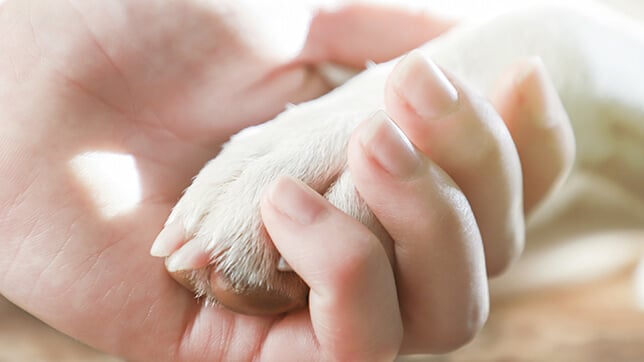3rd October 2024
What to expect when your pet is put to sleep
Losing a loved one is devastating. Our dogs, cats, and horses are part of our families – so, when they pass away, we experience the same grieving process as for the loss of a human loved one.

For some, knowing what to expect when their much-loved dog, cat, or horse is put to sleep can offer a sense of comfort to help them cope with their loss.
Therefore, if you feel it’d help, read on to find out what usually happens when a dog, cat, or horse is put to sleep in a planned euthanasia appointment…
Warning: The following information may be upsetting for some readers – please don’t read any further if you’d rather not know what happens when an animal is put to sleep.
What happens when a dog is put to sleep?
While the procedure of putting a dog to sleep might vary between vet practices, it generally happens as follows:
Step 1 – Depending on a dog’s demeanour, the vet may give them a sedative before moving on with the next step of the euthanasia process (for example, if a dog becomes agitated).
Step 2 – Vets tend to give dogs an overdose of anaesthetic, to ensure that their passing is both painless and stress-free. However, some vets opt to inject directly into a dog’s vein, whereas others prefer to administer anaesthetic intravenously via a cannula (which is held secure by a bandage) and drip.
Generally, a vet will inject or insert a cannula into a front leg.
A dog might feel the slightest ‘pinch’ or ‘sharp scratch’ when a needle or cannula is inserted (as if having a normal injection), though from that moment on, the procedure is entirely pain-free.
Step 3 – As the anaesthetic takes effect, a dog will drift peacefully to sleep, while surrounded by the comforting company and soothing voices of at least one vet and vet nurse. Their heart stops beating, and the vet will confirm they’ve passed away by thoroughly checking the dog’s chest with a stethoscope.
Once a dog has passed peacefully away, it’s normal for them to pass pee or poo and experience some involuntary body twitches.
What happens when a cat is put to sleep?
The process for a cat to be put to sleep is virtually identical to what happens in a canine euthanasia appointment:
Step 1 – Depending on a cat’s temperament (e.g. a distressed feral cat who fears people), the vet may administer a sedative before moving to the next step of the euthanasia process.
For cats, sedative is injected into the scruff of their neck, into a back muscle, or they’ll be clipped so it can be given through a vein in their paw.
Step 2 – Usually, vets will give cats an overdose of anaesthetic, to make sure their passing is both painless and stress-free.
Although a cat might feel the slightest ‘pinch’ or ‘sharp scratch’ when a needle or cannula is inserted (as if having a normal injection), the procedure itself entirely pain-free.
Step 3 – As the anaesthetic takes effect, the cat drifts peacefully to sleep, while surrounded by the comforting company and soothing voices of at least one vet and vet nurse. Eventually, their heart stops beating, and the vet will confirm they’ve passed away by thoroughly checking the cat’s chest with a stethoscope.
After a cat has passed peacefully away, it’s normal for them to pass pee or poo and experience some involuntary body twitches.
What happens when a horse is put to sleep?
Horses are large, heavy animals whose behaviour can be unpredictable at times. Vets who attend the appointment to put a horse to sleep will usually have at least one or two vet nurses or assistants to help them.
Step 1 – If the procedure has been planned, the horse tends to be taken to a quiet, calm field that’s easily accessible by tractors and other vehicles. Sometimes, vets may advise bringing along a horse’s closest companion, which provides comfort for them and the opportunity for their friend to understand, accept, and process their companion’s loss.
Step 2 – Should the horse seem stressed in any way, they will be given medications to calm them down (which could also be done before taking them to the field). Then, the vet will inject an overdose of anaesthetic into a vein on the horse’s neck, which usually causes a horse to collapse within minutes.
It’s essential to follow the vet’s advice to move away if needed, because the way a horse falls can be difficult to predict, and they could hurt their handler accidentally.
Step 3 – Upon falling to the ground, the horse drifts out of consciousness and their heart to stops beating. The vet will continuously monitor the horse’s pulse and checks their heart has definitely stopped before declaring that the horse has passed away.
Just as for dogs and cats, it’s not unusual for a horse’s muscles to twitch or their legs to move after they’ve passed; which could be distressing to witness.
To learn about what happens following a euthanasia appointment, you can read our articles on what happens after your pet has been put to sleep and pet cremation.
If you’re struggling with the prospect of losing your much-loved pet, it’s important to understand the different stages of pet loss grief and reach out for support, as needed.
For access to a range of free resources and advice, please visit our Pet Bereavement Hub.
